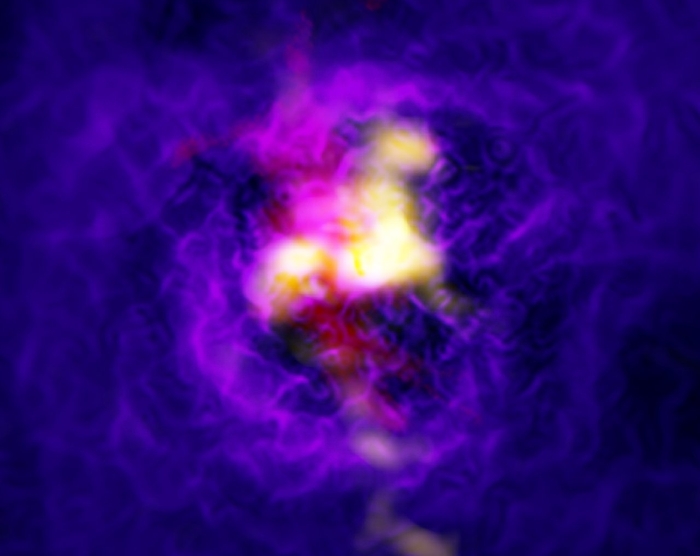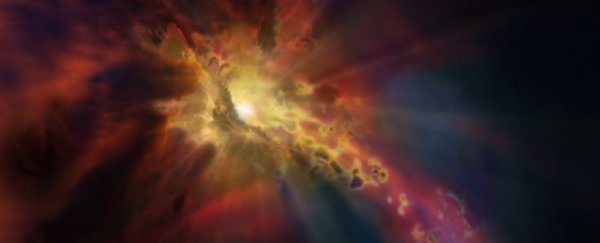Roughly one billion light-years from Earth, a giant elliptical galaxy has been found to be an enthusiastic recycler - albeit not of plastic bottles. The supermassive black hole at its core is blasting cold molecular gas, which is then falling into the black hole, and feeding the cycle anew.
Such a phenomenon is known as a "fountain", a galactic means of recycling star-forming material; long theorised, it's never before been observed in its entirety.
Astronomers found this amazing scene in a galaxy at the heart of a cluster known as Abell 2597.
"This is possibly the first system in which we find clear evidence for both cold molecular gas inflow toward the black hole and outflow or uplift from the jets that the black hole launches," explained Grant Tremblay of the Harvard-Smithsonian Center for Astrophysics.
"The supermassive black hole at the centre of this giant galaxy acts like a mechanical pump in a fountain."
A black hole, of course, doesn't actually spew out material. As an active black hole "feeds", material forms an accretion disc of swirling material that falls into it, like water swirling down a drain. But not all the material ends up swallowed by the black hole.
Some of it is funnelled towards the poles, possibly via magnetic field lines, much like charged particles from solar wind travel along Earth's magnetic field lines to produce aurora.
But the dynamics of a black hole are different; instead of aurora, they produce powerful jets of plasma, travelling at near light-speed into space, blasted out from their polar region.
In the case of the supermassive black hole powering Abell 2597's brightest cluster galaxy (BCG), its jets blast cold molecular gas 9 kiloparsecs (30,000 light-years) into space.
This cold gas then rains back down into the reservoir that feeds into the black hole's accretion disc - a vast filamentary nebula, with a mass equivalent to around 3 billion Suns, spanning 30 kiloparsecs (100,000 light-years) across in the galaxy's centre.
Tremblay and his team first observed this rain back in 2016 using the Atacama Large Millimeter/submillimeter Array (ALMA). They observed molecules of carbon monoxide, some with temperatures as low as 13-23 Kelvin (-260 to -250 degrees Celsius, or -438 to -418 degrees Fahrenheit), falling towards the black hole.
 (ALMA (ESO/NAOJ/NRAO), Tremblay et al.; NRAO/AUI/NSF, B. Saxton; NASA/Chandra; ESO/VLT)
(ALMA (ESO/NAOJ/NRAO), Tremblay et al.; NRAO/AUI/NSF, B. Saxton; NASA/Chandra; ESO/VLT)
Above: This composite image shows the cold infalling gas in yellow from ALMA data, and the hot outflowing gas in red from MUSE data.
Since then, the team connected it to earlier observations made using the MUSE instrument on the ESO's Very Large Telescope. It saw the warmer gas being blasted into space by the black hole's jets.
Follow-up observations using NASA's Chandra X-ray Observatory confirmed this connection - marking the first evidence that the outflow and inflow are part of the same process.
"This very, very hot gas can quickly cool, condense, and precipitate in much the same way that warm, humid air in Earth's atmosphere can spawn rain clouds and precipitation," Tremblay explained in 2016.
"The newly condensed clouds then rain in on the galaxy, fuelling star formation and feeding its supermassive black hole."
The result may only be the first time these two parts of the process have been put together, but it could be quite a common part of galactic evolution, the researchers believe. It could shed some light on star formation, the way black holes feed, and the overall life cycle of galaxies.
The research has been published in The Astrophysical Journal, and can be read on preprint resource arXiv.
